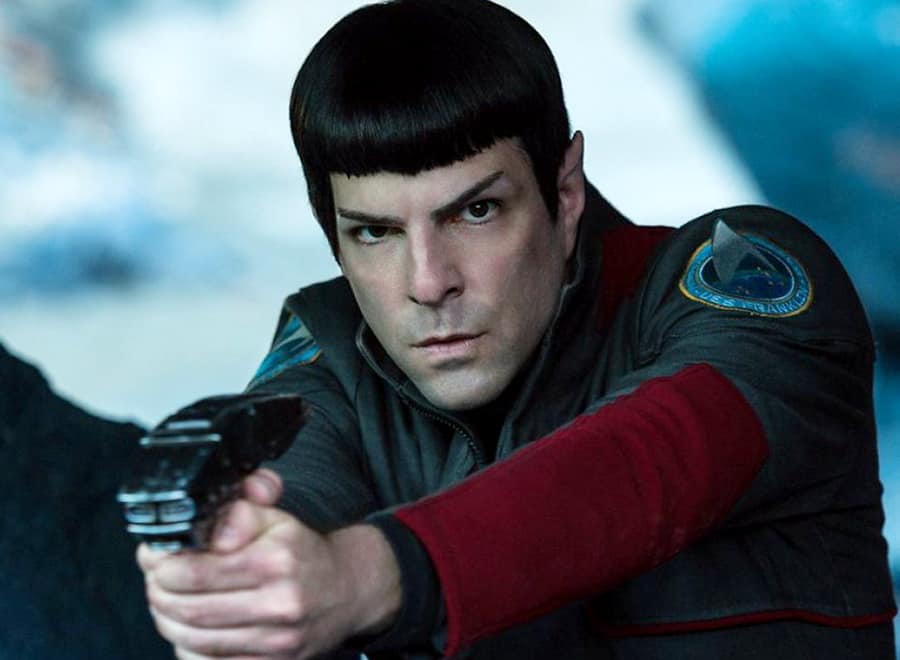
Above: Zachary Quinto as Spock in Star Trek Beyond. There’s nothing like a charged phaser and a squinty look of determination to the far horizon to sum up a Trek adventure. Photo courtesy Paramount.
BitDepth#1050 for July 19, 2016
The celebrations surrounding the 50th anniversary of the airing of the first episode of Gene Roddenberry’s little space cowboy television show, Star Trek, have begun a bit early.
The first episode of Star Trek, now known as The Original Series or TOS, aired just over three weeks from this date on September 08, 1966.
It’s all in support of the release of the latest film in the franchise, the hopefully titled Star Trek Beyond, a film that early buzz suggests is the least TOS-like of all the incarnations of fiction involving people named Kirk, Spock and McCoy.
This is a Star Trek film with it’s own theme song; an Adele-esque turn by Rihanna on a sweeping little ditty called Sledgehammer.
It should have escaped nobody’s notice that the enthusiastic JJ Abrams reboot of the franchise was a huge hit, the daringly time-tossed Star Trek (2009) starring an all-new cast assaying roles first brought to the big screen 30 years earlier in the painfully slow Star Trek: The Motion Picture.
The original series, starring an alarmingly young William Shatner, Leonard Nimoy and DeForest Kelley stumbled along for its three-year run, virtually collapsing under the weight of poor scripts in its third season.
The show would also be the proving ground for the potential of syndication, the relicensing of creative content for reuse in multiple markets, which Paramount (who had bought the series from original producers Desilu – yes, we owe Kirk and Spock to I Love Lucy), explored with increasing success. CBS now owns the right to the brand, and is developing a new television series while Paramount retains the right to make films using the brand.
The series was first revived as Star Trek: The Animated Series in 1973, winning an Emmy Award for Best Series, using then state-of-the-art cel animation.
The first film, riding the unquenchable thirst stoked by continuous global syndication, arrived in 1979, a deeply flawed effort to expand a 45 minute concept into a 132 minute movie.
Paramount pushed series creator Roddenberry aside for its sequel, Star Trek II: The Wrath of Khan (1982), which under the steady, capable hands of director Nicholas Meyer, became not only the strongest entry in the original series’ film catalog, it was mined liberally for the cloned underpinnings of 2013’s largely disappointing and ham-handed Star Trek: Into Darkness.
In television, Paramount has had varying success with its efforts to introduce a new cast and crew to the Enterprise and in expanding the well-populated universe that Gene Roddenberry envisioned.
The best of them, Star Trek: Next Generation (1987), dumped the crew entirely and introduced a newer, sleeker ship launched under the Enterprise name and a complex and engaging captain, Patrick Stewart’s Jean-Luc Picard.
Deep Space Nine (1993) suffered the Stalag 13 curse, binding its cast to an orbiting space station and requiring all of space to come to them. DS9 benefited from the bold presence of Avery Brooks as Station Commander Benjamin Sisko and in its last two seasons, finally did a bit of spacefaring.
Voyager (1995), delivered an adult version of Lost in Space, largely descending into an endless cycle of weekly aliens while losing the opportunity to explore, with a much larger budget, the original premise of TOS’ five-year mission of exploration.
Star Trek on television would end on an ignominious note of lost opportunity with Enterprise (2001), a series that began quite hopefully, detailing the earliest days of space exploration in Mr Roddenberry’s halcyon future of rocketry, but quickly lost its way.
The final season was wrestled back on course, but too late to save a series wounded by the lack of a coherent vision for its cast and storytelling.
Scattered among the hundreds of hours of storytelling and performance that represent the 50-year legacy of Star Trek are some remarkable, truly memorable moments along with some gaffes of epic proportions, but the series that began it all in September 1966 has always managed to be, at its best, both inspirational and aspirational.
It’s celebration of largely imagined but impressively considered hard science was capably buffered by an emphasis on the importance of a unified humanity in the face of an unfathomable unknown couched in the neutral ruthlessness of open space.
To look now at the clunky sets of TOS, the flimsy furniture, the miniskirts (never a bad idea) and the communicators, an item designed for the far future that already looks antique, is to hope that the young viewers of Star Trek Beyond live into a future that makes the slick super-modernity of this year’s Trek film commonplace and perhaps, even a little dated in another fifty years.


